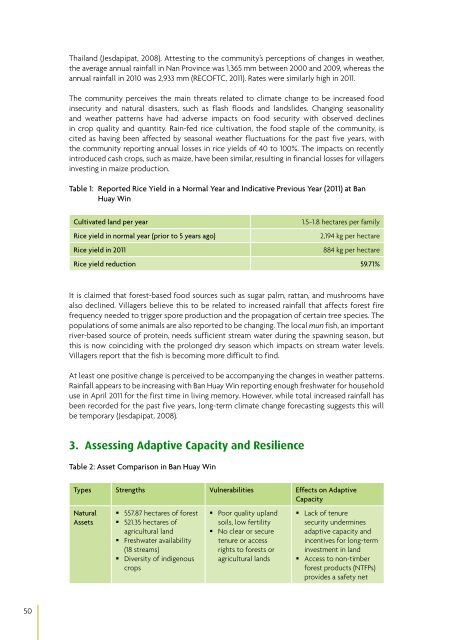Adaptation case studies.pdf - RECOFTC
Adaptation case studies.pdf - RECOFTC
Adaptation case studies.pdf - RECOFTC
Create successful ePaper yourself
Turn your PDF publications into a flip-book with our unique Google optimized e-Paper software.
Thailand (Jesdapipat, 2008). Attesting to the community’s perceptions of changes in weather,the average annual rainfall in Nan Province was 1,365 mm between 2000 and 2009, whereas theannual rainfall in 2010 was 2,933 mm (<strong>RECOFTC</strong>, 2011). Rates were similarly high in 2011.The community perceives the main threats related to climate change to be increased foodinsecurity and natural disasters, such as flash floods and landslides. Changing seasonalityand weather patterns have had adverse impacts on food security with observed declinesin crop quality and quantity. Rain-fed rice cultivation, the food staple of the community, iscited as having been affected by seasonal weather fluctuations for the past five years, withthe community reporting annual losses in rice yields of 40 to 100%. The impacts on recentlyintroduced cash crops, such as maize, have been similar, resulting in financial losses for villagersinvesting in maize production.Table 1: Reported Rice Yield in a Normal Year and Indicative Previous Year (2011) at BanHuay WinCultivated land per year1.5−1.8 hectares per familyRice yield in normal year (prior to 5 years ago)2,194 kg per hectareRice yield in 2011884 kg per hectareRice yield reduction 59.71%It is claimed that forest-based food sources such as sugar palm, rattan, and mushrooms havealso declined. Villagers believe this to be related to increased rainfall that affects forest firefrequency needed to trigger spore production and the propagation of certain tree species. Thepopulations of some animals are also reported to be changing. The local mun fish, an importantriver-based source of protein, needs sufficient stream water during the spawning season, butthis is now coinciding with the prolonged dry season which impacts on stream water levels.Villagers report that the fish is becoming more difficult to find.At least one positive change is perceived to be accompanying the changes in weather patterns.Rainfall appears to be increasing with Ban Huay Win reporting enough freshwater for householduse in April 2011 for the first time in living memory. However, while total increased rainfall hasbeen recorded for the past five years, long-term climate change forecasting suggests this willbe temporary (Jesdapipat, 2008).3. Assessing Adaptive Capacity and ResilienceTable 2: Asset Comparison in Ban Huay WinTypes Strengths Vulnerabilities Effects on AdaptiveCapacityNaturalAssets• 557.87 hectares of forest• 521.35 hectares ofagricultural land• Freshwater availability(18 streams)• Diversity of indigenouscrops• Poor quality uplandsoils, low fertility• No clear or securetenure or accessrights to forests oragricultural lands• Lack of tenuresecurity underminesadaptive capacity andincentives for long-terminvestment in land• Access to non-timberforest products (NTFPs)provides a safety net50
















